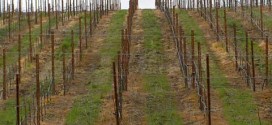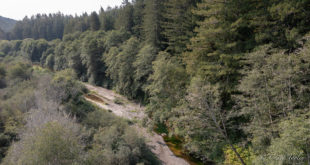| A version of this article was published in the Independent Coast Observer on April 29, 2005. |
Sonoma studies vineyard conversions
By Jo Rouse and Julie Verran
Courtesy Independent Coast Observer, Gualala, CA
Sonoma County is pondering ways to regulate the conversion of redwood and Douglas fir forests to vineyards.
Last week the planning commission listened to four hours of comment on a draft forest conversion ordinance that was presented in seven distinct alternatives.
At their meeting May 12, the commissioners will continue their discussion and may come to a decision. They have plenty of time; the next step for the proposed ordinance is a Board of Supervisors hearing set for June 21.
The California Department of Forestry regulates vineyard conversions with a two-step process involving a timber harvest plan and a separate conversion document prepared by a different office. CDF officials have said that county policy would help them by setting local standards. The ordinance could do that by setting which zoning, if any, could allow timberland conversions.
About 90 people turned out Thursday at the hearing in Santa Rosa. Most speakers favored one of three alternatives. Option three would limit zoning where conversion could be done, option five would allow conversion if two acres of overcut timberland would be re-stocked for each one acre of timberland planted to grapes, and option seven would simply ban timberland conversion to agricultural use. Oak woodlands and brushland would not be affected by the ordinance, nor are they regulated by CDF.
“Forests provide many more benefits than just timber,” said Margaret Pennington for the Sierra Club. She reminded the commission that it was John Muir’s birthday, and turned in 1,000 cards from members supporting option three and rejecting option five. The Sierra Club contends that “no net loss is a misnomer” that really means no net protection.
Other groups told the commission that the Gualala River watershed, where most Sonoma County vineyard conversions are located, is listed as impaired by excess sediment. Conversions involve removing all vegetation from acreage slated for grapes, removing the roots and ripping the soil.
The Town Hall Coalition from Sebastopol asked the county to support option seven and abandon timber conversion altogether, based on water availability. Vineyards require more water than mature forests, and young, growing forests require lots of water, making the two-acre for one “no net loss” option five too heavy a burden on the county’s limited water supply.
Chris Poehlmann of Annapolis, speaking for Friends of the Gualala River, gave a slide presentation including aerial views of ridgetops converted to vineyards. He said that the California Public Employees Retirement System is financially backing several conversions, including a proposal by Premier Pacific Vineyards to convert 1,900 acres of their 19,000-acre Preservation Ranch near Annapolis to grapes.
(For more information, see Premier Pacific on Fast Track by Christopher Sawyer in the February, 2005 issue of Wine Business Monthly.)
A Registered Professional Forester said the county should not add another layer of costly regulation to the existing process, adding that the agriculture designation applies to trees and grapes both.
John Holland of Annapolis said the ridgetops sought for vineyards there are designated by the county as groundwater recharge areas.
“No net loss is loss, period,” said Peter Ashcroft of Santa Rosa, asking the commission to reject option five. He added that values at stake include habitat fragmentation and loss of birds, fish and mammals.
Henry Alden, forester for Gualala Redwoods, Inc. said 15,000 of the firm’s 30,000 acres are in Sonoma County. Regulations are already so restrictive GRI may not survive without the option to convert as one of the ways to keep the business viable. Of GRI’s Sonoma County land, only about 300 acres would be suitable for conversion, Alden said.
An attorney for Preservation Ranch said the proposed county ordinance is pre-empted by California’s Z’Berg-Nejedly Forest Practice Act, and advised the county to slow down. The state Supreme Court is about to come out with a ruling affecting the Forest Practice Act, he added.
Chairman Don Bennett closed the public hearing. After a break, commissioners listened to comments from staff. Gail Davis of the county agricultural commissioner’s office said that many proposed projects are on the steeper hillsides that seem to produce better grapes.
Planner Greg Carr said the question is whether the county is going to treat its timber resources as it does its agricultural resources.
# # #
 Friends of Gualala River Protecting the Gualala River watershed and the species living within it
Friends of Gualala River Protecting the Gualala River watershed and the species living within it


